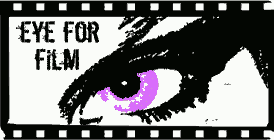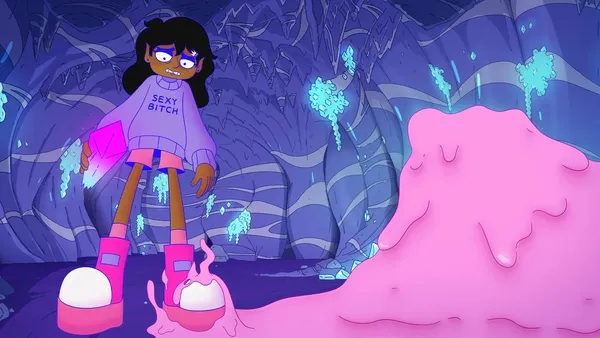 |
| Lesbian Space Princess |
Think of an event as prestigious as the Berlin International Film Festival and you probably don’t think of neurotic princesses travelling through the galaxy trying to save their bounty hunter exes from being drowned in vats of toxic homebrew, but Lesbian Space Princess is a natural crowd-pleaser which can find a home wherever it touches down. It’s the creation of Leela Varghese and Emma Hough Hobbs, two young Australians who are as ambitious as they are talented. I caught up with them not long after they arrived in the city to ask how they managed to make such a splash with their first feature.
“It's part of a film lab in South Australia run by the South Australian Film Corporation, called Film Lab New Voices,” Leela explains. “Basically it's a low budget feature film initiative to help underrepresented voices get their first time writing and directing a feature. So that was like the inspiration for coming up with something. To be honest, I never felt entitled to make a feature film, and so I think that really opened the window, as well as Emma encouraging me to go for it.”
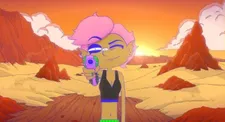 |
| The object of Saira's affections |
“You didn't seem to be going for it,” Emma reminds her, “so I was talking to other people about applying, and then...”
“...and then I kind of got jealous,” Leela admits. “And then we ended up in a mild argument. And then Emma had a shower.”
Emma nods. “Yeah. I stormed off, and I said ‘I don't see you pitching me anything in the shower.’ And in the fog and the steam of the shower, the words lesbian space princess emerged. And I ran out, dripping wet, and I pitched it.”
“At first I was not sold,” says Leela. “At first I was a bit like, ‘That's so silly. Will anyone ever take us seriously if we make a film called that?’ And then it just kind of stuck with us. And we figured that if we could have such a grabbing title, but also make sure that it was a story that we really wanted to tell, we could still do something really important and meaningful to us. It was title first, for sure.”
“We were like, ‘Okay, so it's camp, but then there's the heart,’” Emma recalls. “We started talking about it. We were thinking initially like a Cowboy Be-Bop, but a lesbian version. And then we're like, ‘Oh, but that's quite typical. You know, there's a lot of stuff like that that exists. What's more true to us?’”
“I think there is a world where like the Kiki character [the bounty hunter] could have been the main character,” says Leela, “but we felt like that has sort of been done in Cowboy Be-Bop. That also felt like much more of a masculine approach to a story. And so we went, ‘Let's look at who we are. Let's create a character that feels authentic to us.’ And that's how Saira was born. She's basically like a mixture of the two of us, in some ways. It's funny to think of her as a mixture of our anxieties and insecurities as well.”
I put it to her that princesses in stories like that are traditionally there to be saved, but in recent years we’ve been starting to see more femme characters who get to drive the action and tell their own stories. Did she feel like part of something in telling that story that way?
“It's funny,” she says. “That was a big conversation when we were writing the story, about the idea of flipping who's saving who. But do ewe feel like we're a part of something with that? I mean, I guess so, yeah.”
“It’s such a female forward film,” observes Emma. “I think having empowered female characters is a part of that general narrative. And it's great to see more films like that, especially because we're female creatives as well. I feel like when you have women writing films, we're going to write less passive women.”
I note that over my three decades as a critic I've seen so female voices in film come through a lot more, and I've seen a lot of other minority voices start to grow, but there's still very little visibility for lesbians. Why do they think that is?
“We talked about this the other day,” says Leela. “I think it's because there's just not the support like what we very luckily got. It’s still such a low budget, but we had the Initiative take that chance on us. I think there is actually a lot of lesbian content, but it's maybe not breaking out into the more mainstream festivals.”
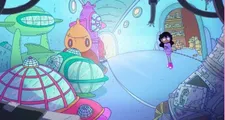 |
| Saira prepares to leave her safe space |
“Yeah, I think that it's still seen as a real niche,” says Emma. “Even when we were going for funding with this, we were told ‘Oh, well, that's quite niche. Where is the broader appeal?’ I think there's the idea that when it's men who love men, that's got a broad appeal. Who wouldn't love that? Everyone loves that. But then lesbians still, people don't make the leap to see the broader commercial appeal.”
Leela agrees. “And it's so interesting with this movie because, you know, it has a surprisingly broader appeal than I think a lot of people would have thought. The mix of people that we've seen showing interest in it has been surprising. It's not just the queer community. So to assume that every queer film is going to only have a niche audience, maybe that’s part of the problem too.”
We talk about the humour in the film, with its mixture of queer community in-jokes and more broadly accessible material.
“I think that just happened naturally,” says Leela. “Everything that I make has people of color and it's queer, but it's often quite accessible. I even did a comedy band with Shabana Azeez, who plays Saira. We were in a musical comedy band called the Coconuts, which was talking about our experiences being women of color in musical comedy. But our band was selling out shows and a lot of the audience was older white people, which was really interesting.”
“I'm a big fan of high risk, high reward comedy,” says Emma. “There's a lot of referential stuff in the film and I think ultimately, from my perspective, we were writing it for the queer community first and foremost. The more that they feel like the jokes are just for them, it creates a special atmosphere and then people have fun.”
“It’s an interesting one because just by nature of what the story is, it's actually quite broadly appealing to people,” Leela observes.
Emma adds that at their work-in-progress screening in Adelaide, she could tell a lot about the different groups of people in the audience based on when they laughed.
“There's the bit where [Saire] says ‘I have to keep my nails short anyway,’ and you can always just hear a few lesbians,” says Leela.
I tell her I like the fact that although Saira is a lesbian, and that still more niche thing – a lesbian without a girlfriend – the story isn't all about her romantic relationships. It’s about her finding herself in a different way and being her own person. So sexuality is important to it, but also her seeing a little bit beyond her sexuality.
“Moving away from stories that are so focused on sexuality was definitely something that we wanted to do,” says Leela. “We didn't want her sexuality to be the tragedy of that character. We just wanted to create a character who had a struggle. The focus of the story actually isn't about being queer. It's about being surrounded by queerness, but it's quite a universal story.”
“Yeah,” says Emma. “But also, conversely, part of the inspiration for Saira's deficit of self love is because we see that a lot in the lesbian community. A lot of us tend to relationship hop because there's a fear of being alone and being okay with that. And so we felt like that was also an important message for the queer community to relate to specifically.”
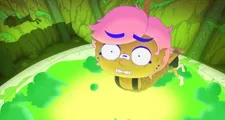 |
| Kiki finds herself in peril |
“I think everyone struggles with self worth,” says Leela. “It's something that we struggled with, continue to struggle with. I wish I could say that we made this movie and that we can stand on a hill and say that we're the best example of loving yourself and self worth. But it's different on every day how you feel about your self worth.”
I tell her that I'm not sure I've met anybody creative who has complete confidence in their self worth. I'm not sure those things go together.
“Yeah, yeah, maybe that would be too terrifying,” she says.
We move on to talk about the science fiction elements of the film.
“We're big fans of genre,” says Emma. “I love sci-fi. I grew up with sci-fi and animation. A big part of this is growing up as an awkward girl nerd, and just not seeing that queer feminist content out there, and also not feeling very comfortable in those fan spaces. So it's like, how can we take the beautiful thing about science fiction and make it with a queer lens? We were just having fun.
“Part of the world of Lesbian Space Princess is that we flip the social dynamic of today and we go, ‘Okay, you know, thousands of years in the future, obviously lesbians and women of colour are running the show, and incels are forgotten. They’re relics at the edges of the universe. You can do that with science fiction. It’s a really good vehicle for social commentary.”
I mention that the straight white maliens who kidnap Kiki remind me of a certain kind of men whom one often encounters at science fiction conventions.
“We were just drawing from our own experience with different kinds of men,” says Leela, and Emma agrees.
“It wasn’t nerds in particular obviously. There's incels that are also a little bit nerdy. You know, we gave one of them a neck beard, which is like generally associated with convention culture. But that's not predominantly where we're coming from. It's more like men who feel entitled to own women.”
“For me, I think it was about like seeing a shift in the industry in terms of like who's being supported,” says Leela. “It was about hearing a lot of men feel like they were like not being supported anymore, and were saying that it was easier for someone like me to make it in the industry now. Maybe also it's seeing that reaction to different voices getting a chance to tell their story. Just the amount of entitlement that I've seen from men feeling quite screwed over. I found that interesting. Especially the idea of us being first time female directors, and our film also comments on that, I think in a playful way. I don't want to be too mean.”
I tell her that I don't think she’s mean and that, for me, a lot of what makes the film workis the affection and sympathy it finds even for its antagonists. Was it always important to her to keep that positivity, and the idea that there's a way for things to be better for everyone?
“I think for me it's just genuinely how I feel about most situations,” she says. “I think I genuinely can always empathise with – well, obviously not a certain group of people. But this idea of women against men, it's not real to me. I can understand the frustrations that I hear them talk about, and there is empathy there.”
Empathy is built into the story, Emma points out.
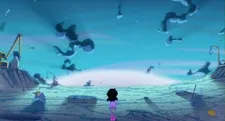 |
| Saira sums up her courage |
“Ultimately Saira and the quote ‘villains’, the maliens, they parallel each other in so many different ways, because ultimately it's like they're just distracted by what they think they need instead of what they actually need. The big inspirational speech at the end is exactly the same and it's completely relevant to both parties. So it's not about gender wars because there's a lot of common ground with those characters.”
“Often with people that you meet that are angry or frustrated or have these intense opinions, it does trace back to self worth and self value, you know?” says Leela. “Those feelings can only come from something going on with those people. You kind of feel sorry for someone when they're so intense and angry at the world because it must be hard to be like that. You know, what happened? Are they okay?”
We move on to talk about process and the style of animation in the film.
“I'm an animator. That's part of my background, and that style is just the way that I've drawn characters,” says Emma. “It's obviously very inspired by Adventure Time, but with more of a queer kind of unique flair.”
“It's very much coming from Emma and basically represents Emma as an animator in production design and character looks,” says Leela.
Emma is keen to give credit to the whole team.
“We had two full time animators on the entire project. They got to know the project and us, and we collaborated intensely with them. And we had two part time background artists as well, who were very generous in terms of ideas for jokes. It was a lot of fun making the film with such a small team over a long period of time because it really helped create the feeling of the film.”
“It was very much not like a big budget film where there's a casting agent,” says Leela of the other side of the team. “It was done with our producer Tom Phillips, the production company and us, and getting in contact with people we liked or people or comedians we were fans of, or drag queens we were fans of. With Blade, I think we definitely had Queen Kong in our mind the whole time we were writing that character. But it was just a scouting kind of thing, going out and scouting amazing, hilarious Australian talent.
“Gemma, who plays Willow, heard about it through another person who had received the script, and then Gemma's agent actually asked us if Gemma could audition. So Gemma found the film, which was pretty cool. Serendipitous.”
“We had a spreadsheet and a dream,” says Emma. “I’m such a big fan of all of the cast. I'm obsessed with Richard Roxburgh and we're big fans of Madeline Sami.”
“They're all people that we fangirled over, I guess,” says Leela.
So after all that, how does it feel to be screening in Berlin? Did they ever expect this kind of attention?
“I did not. I absolutely did no,” says Leela.
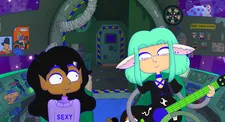 |
| Lesbian Space Princess |
Emma’s response is more qualified. “You never know how it's going to go. It feels like the film for us is like us pulsing a light into the darkness, queer filmmakers making animated. queer sci fi content in that animation space.”
“You're kind of like, is anyone out there?” Leela adds, but says she’s delighted by how nice everybody on the Berlin team has been.
“We would love to make like more features,” she says. “I am super keen to also get the chance to make a live action feature as well. And we've also got other animated ideas. Basically we just want to get to make stories. If we could keep making feature after feature after feature, that would be really fun.”
